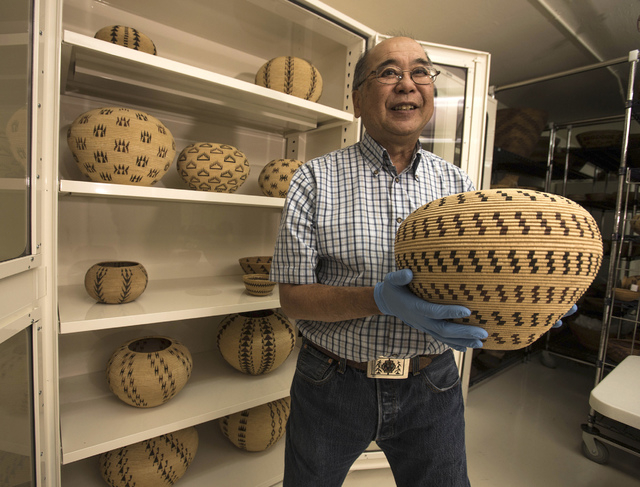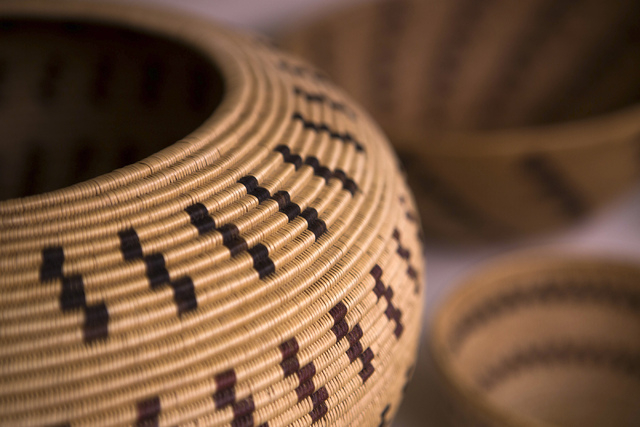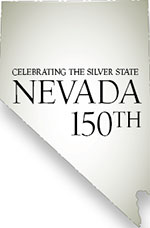Washoe Indian woman’s art adorns museums
CARSON CITY
Before she died in December 1925, the Washoe Indian basket maker called Dat So La Lee insisted that she should be buried with one of her baskets.
Authorities complied with her request. The Carson City Daily Appeal wrote that Dat So La Lee, one of the most famous American Indian women in the country, was buried near the Stewart Indian School with one of her “$1,000 baskets.”
Today her baskets fetch from $200,000 up to $1 million, if you can find them. She weaved only 120 known baskets in her lifetime at 33 weavings to an inch, taking half a year to make some.
“Her work was perfect,” said state archaeologist Gene Hattori as he walked through the vault at the Nevada State Museum that holds 19 of Dat So La Lee’s baskets and about 100 other perfect-looking baskets made by Indian weavers 100 or more years ago. If there is a flaw, in a close examination of her baskets, the uninitiated won’t find it.
But the experts know perfection. Other Indian weavers knew she was the best, Hattori said, speculating that her fellow weavers did not like her because of their jealousy over her perfection.
She was a heavy-set Indian woman born in Douglas County in 1829, according to her promoters, Carson City merchants Abe and Amy Cohn. She had been doing their laundry. Her real birth date probably was closer to 1850, but the Cohns embellished the date so they could create a legend that she greeted explorer John C. Fremont when he visited Nevada in 1843-44.
In today’s parlance, the Cohns would be considered exploiters. They put Dat So La Lee and her husband, Charley Keyser, in a tiny two-room wood building next to their big brick mansion, not far from the state capitol. Both homes remain today. Dat So La Lee’s 300-square-foot home rents for $550 a month.
The Cohns paid her living expenses, took her on tours of the country and had her weave from the front window of their stores in Lake Tahoe and Carson City. That was during the arts and crafts period of American history, according to Hattori, and people wanted anything Indians made.
While the crowds who gathered to watch her weave could not afford the baskets, Cohn figured it was good for his business. They would buy less expensive merchandise while they watched.
Legendary photographer Edward Curtis, who photographed American Indians at a time when they were considered vanishing Americans, arrived in Carson City just before her death to photograph Dat So La Lee.
Yale University and the Smithsonian Institution purchased her baskets. But few people could afford her prices, fortunately for today’s Nevadans, because the Cohn family in 1945 donated 10 baskets to the Nevada State Museum in Carson City and 10 baskets to the Nevada Historical Society in Reno. Hattori figured she weaved other baskets for money when the Kohns weren’t watching. He added she also made cradle boards. Her baskets are displayed periodically in other state museums.
She was born as “Dubuda,” meaning Young Willow, a fitting name because she used willow that she soaked in water to create her baskets. She would start with three strands of willow and then weave strands around them, starting with a flat base and expanding to a wide circumference and then tapering back and leaving a hole in the top. This became the “degikup” weaving style popular among Washoe weavers.
Dat So La Lee was a made-up name supposedly taken from the initial of Carson City physician Dr. Samuel L. Lee. She had been a maid in his home before the Cohns discovered her self-learned weaving ability in 1895.
One wishes she had been asked what she was thinking while she weaved. Hattori suggested she may have been in an enlightened Zen state, with the weavings appearing automatically without thought.
In her personal life, she preferred to be called by her Anglo name, Louisa Keyser. She and her husband had no children.
In a 2001 interview, Carson City resident Winona James, then at 98 the oldest Washoe, remembers her as Louisa Keyser, her step-grandmother.
“I watched her work, but I didn’t pay close attention,” James said.
When you are young, you don’t recognize things as special. I remember her hands were very nimble.”
In 1978 a thief stole four baskets from the Historical Society. One was recovered two years later after the state paid a $1,500 “finder’s fee.” The others were returned in 1998 after Paul Shepard, a Tucson, Ariz., art dealer, sent them to an art dealer in Palm Springs, Calif., for appraisal.
The dealer sent photos of the baskets to University of British Columbia art professor Marvin Cohodas, an expert on American Indian basketry. He quickly identified them as the stolen baskets.
That time the state paid $55,000 for the return of the baskets. Despite an extensive investigation by the FBI, no one was prosecuted. The money covered what Shepard had paid for them.
When he brought the baskets back from Arizona, then Historical Society Director Peter Bandurraga, bought three seats on an airliner. He wasn’t about to stow them with the luggage.
You can’t be too careful with perfection.
Contact Capital Bureau Chief Ed Vogel at evogel@reviewjournal.com or 775-687-3901.





















